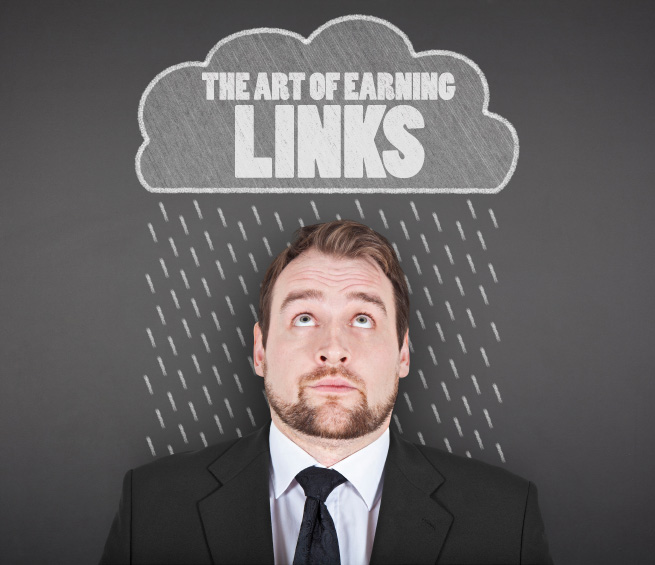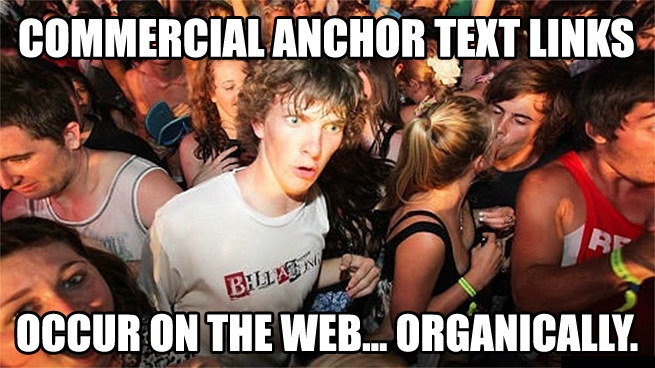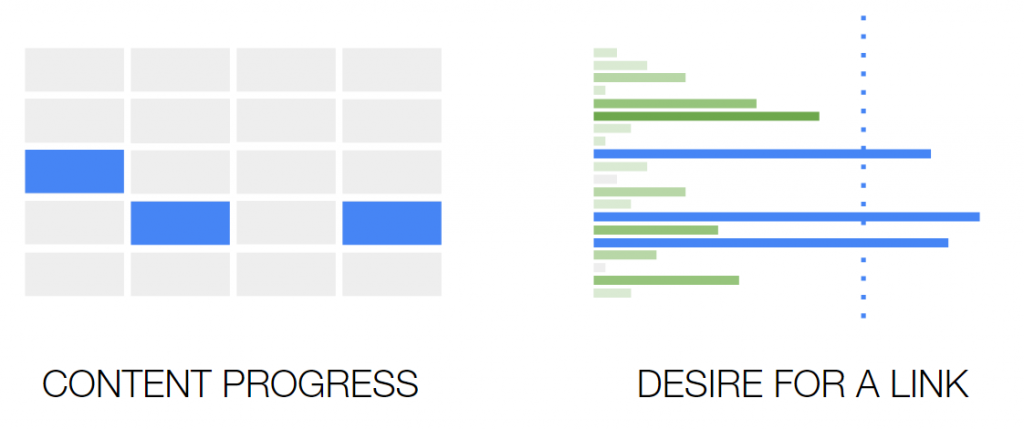NOTE: An updated, 2016 study is available here.
Exactly two years ago, I published a little study on link anatomy [PDF] from link builder’s point of view and many were surprised to see so many attributes attached to something so simple as a link. Today will focus on the left hemisphere of the diagram with attention to organic acquisition scenarios (excluding any direct manipulation in the link earning process).

Background
Link-based SEO techniques are gradually giving way to other practices as our industry goes through a content marketing phase. While everyone’s on board with it, few consider how content truly fits into their digital strategy and why they are doing it. For many, content is simply a link generation tactic, which has replaced link exchange, paid directories, link networks and will eventually be replaced itself.
Links are still important
Here’s the thing many seem to be forgetting lately. Google is a link-based search engine, links are at its core, in its DNA. Unless somebody new comes and completely rewrites their algorithm, Google will continue to rely on links in conjunction with a variety of other signals for a long time to come. Don’t ignore links, they’re by far the strongest signal, particularly anchor text.
What has changed is Google’s ability to detect inorganic link patterns. At this point in time, their link spam algorithms are good enough. Not great, but good enough. This means that link and anchor text manipulation on any level no longer represent a viable option for serious businesses.
If you tell the truth, you don’t have to remember anything.
— Mark Twain
Organic vs Inorganic
- Did you make the link yourself?
- Did you ask a webmaster for it?
- Did you pay for a link or give goods or services?
- Did you ask for anchor text correction?
Yes? Then it’s inorganic. It’s as simple as that, really. It doesn’t matter that your content is great, or if there’s a context or purpose for the link to exist. Google wants links to appear naturally so no matter what you do and how you mask it, eventually it might be devalued or have a negative impact on your websites’ performance. Google is threatened by clever link tactics due to low confidence in identification of such links, this is the main reason for various actions and penalties. As they work their way up to more sophisticated link schemes, everything you do now could potentially represent a threat in the future.
This is why organic link earning is a good idea. My top priority right now is to create a set of safe and timeless outreach and content generation guidelines for my own team.
Message for Google
Things are going pretty well, don’t screw this up. Your enhanced ability to catch spam followed by aggressive linkspam actions in the last few years have finally started making a dent. Webmasters are gradually abandoning unsafe link practices due to an increased risk of algorithmic and manual actions. This is a good time to show that you’re really rewarding high quality websites and one of the best ways to show this is to invest further into catching spam. Invest more time and money in search quality and anti-spam mechanisms.
There is nothing more frustrating than watching your website lose organic search traffic to somebody you know is spamming and getting away with it. Given enough time Google, if you don’t take action against everyone fairly you’re basically convincing the good guy to abandon best practices and catch up to spammers in their spammy ways. If it works, then why not? We’ll deal with the penalty when it comes, in the meantime we’re funnelling profits and growing our business.
Stop with petty actions against naive and gullible webmasters and look at handling things on an algorithmic level – with confidence. Once you gain the confidence in your results on an algorithmic level, you’ll be able to safely drop the manual policing of whatever the trend it is that webmasters are talking about. You’ll simply know that whatever people in the world come up with your algorithm can handle it.
Why do links exist on the web?
Link Classification Challenges
While preparing to write this article I spent a great deal of time thinking about links and how they can be classified. In order to back up my initial notions I used Google Surveys, personal contacts and opinions of people in the blogosphere. Initially I surveyed 2,562 individuals of whom I found 795 to qualify for the study. I asked them all the same question: Why do you link to other websites?
Here’s a sample of responses and the categories I formed in order to group the terms:
Sharing: “to share”, “sharing info”, “to share things I find interesting”, “spread knowledge”
Relevance: “ideas”, “info”, “story”, “facts”, “to widen the discussion and connect ideas”, “to provide readers with interesting stories”, “relevance”, “opinion”
Attribution: “to give them credit if i mention them”
Entertainment: “cause they are funny”, “to have fun, enjoyement:
Marketing: “marketing”, “seo”, “online image”, “gain followers”, “hits”
This data sample was enough to make me realise two things I haven’t considered (or thought about much) before. (1) Entertainment value and emotions play role in deciding whether to link to something or not (not a huge surprise). (2) People do link organically for promotional purposes and commercial gain.
Now, this one took time to digest…

Subscribe to our real estate newsletter, buy my organic makeup, we sell designer beer…
Genuine motivation behind some organic links on the web is commercial gain and self-promotion and those links should be treated as a sub-set of organic links by Google. The problem is that it’s too hard to know if somebody is fiddling with anchor text purely to manipulate rankings or not.
User-Centric Link Needs
Every link must have a strong purpose and it must lead to the strongest possible page. This means we can’t link from random words to random pages. Instead we must anticipate the link’s utility in the given context of the narrative. If the link doesn’t have a strong purpose to exist then it shouldn’t be a link.

Merit-Based Link Classification
Context is typically considered to be the primary reason for all links to exist. I decided to break down what we call “context” into eight (often overlapping) reasons for links to exist on the web:
- Attribution
- Citation
- Definition
- Expansion
- Identification
- Example
- Action
- Relationship
Attribution – Crediting original authors for using their content
Most cases of link-based attribution I’ve seen so far were based on the image use, but it can be any media type.
(Overlaps with Identification)

Example: Search Engine Land
Reference – Quoting a statement from another author
Often used in form of a citation, providing further proof to support an idea, statement or a claim.
(Overlaps with Attribution and Expansion)

Example: Moz
Definition – Linking to a page which defines a concept
This link type generally exists to define a potentially new concept unknown to some readers.
(Overlaps with Expansion)

Example: icrossing
Expansion – Providing a path to an in-depth resource
Used to point to an in-depth resource which elaborates on a discussed subject in greater detail.
(Overlaps with Context)

Examples: Search Engine Journal
Identification – Disclosure of contextually relevant entities
Typically a link to an official page or a primary contextual item for a place, brand or person. This could be an organisation’s website, profile page, Wikipedia article and often social media.
(Overlaps with Definition, Relationship)

Example: SEO Roundtable
Example – Practical illustration of discussed entities and ideas
Using one or more examples real-world examples to clarify and inform.
(Overlaps with Expansion)

Examples: Blind Five Year Old
Action – Inviting users to perform an activity
Call to action based links are common in both contextual as well as commercial sense. Authors may invite their audience to try out new things in order to experience the described concepts first hand. Action-based links I’ve seen so far are often self-generated and promotional nature (e.g. newsletter signups, free e-book, follow on Twitter, buy my product, free trial.). This includes community engagement and crowd-sourcing outreach efforts.
(Overlaps with Identification, Relationship)

Example: RossHudgens.com
Relationship – Engagement and connectivity based linking
People, businesses, organisations are connected on many levels, both on-line and in the real world. It’s common to see one organisation link to another based on shared interest, activity, status or engagement.

Example: 2013 National Cyber Security Awareness Week
Research Continues
In this article I’ve touched on the subject of why we link, the next part in my investigation will be around how we link. Our ongoing research activities include both qualitative and quantitative components and we’re utilising:
- 80legs and Ancore-based process for large-scale anchor text extraction. [Automated]
- Survey [Automated]
- Link Classification [Manual]
- Interviews [Manual]
2023 research shows that an average number of external links on a blog post is 18, ranging from 2 to 256.

Our data also shows that spammy websites tend to restrict a number of links on the paid guest post articles in order to make them look less spammy. I refer to it as a 1+2 rule. One link for your client and two to random authority sites to make it look natural. Ironically this makes those sites look less natural bringing the average of external links per page down to only five.
Dan Petrovic, the managing director of DEJAN, is Australia’s best-known name in the field of search engine optimisation. Dan is a web author, innovator and a highly regarded search industry event speaker.
ORCID iD: https://orcid.org/0000-0002-6886-3211
-
Dan Petrovichttps://dejanmarketing.com/author/dejan/
-
Dan Petrovichttps://dejanmarketing.com/author/dejan/
-
Dan Petrovichttps://dejanmarketing.com/author/dejan/
-
Dan Petrovichttps://dejanmarketing.com/author/dejan/

Great article, Dan. I don’t believe I’ve ever seen such a detailed classification of links listed before! Whenever questioned about the current value of links, I always like to reference the Eric Enge, Matt Cutts interview earlier in the year, where Matt says Google is still much very dependent on links for evaluating authority and that the link graph is alive and well. I predict we’ll start seeing newer signals like social and authorship start to play a larger role in the next year, but these of course, are also just links.
Great article Dan and something I think will be helpful to a lot of beginner link builders and marketers. You have to understand the motivations behind why people link in order to build assets that are link worthy and promote them.
Certainly agree with your pitch at Google – although I’m not sure they will take notice. There is certainly a culture of churn and burn in place now, with people I know throwing up a landing page designed to either get email leads or the phone ringing. These sales pages are ranked through common spam techniques and will stay high in the results for 1 to 3 months until they are flagged and no longer get visitors. Once they are worthless a new page is thrown up and ranked again using the same techniques. Interestingly a lot of these pages are being hosted on Blogger – you would have thought Google would be all over its own sites.
Totally agree Brian, I also recall that great interview…however it is not clear whether Google will start using Authorship data or not, me reading between the lines, I think they just didn’t figured out yet how to do it, but they sure do want to do so…then maybe Links will loose some more importance. it’s the future very soon enough
Great article and piece of advice especially for those who want to learn more about SEO.
Dan, good name and great article! I too believe that the way Google indexes websites is heavily dependent on links (they even say so in the first part of their ‘How Search Works’ as evidence I commonly cite for client education purposes) and will be into the foreseeable future. Your point about “inorganic” links holds true, even though many guest posting blogging services are essentially examples of this. The thing is, some forms of guest blogging, and I emphasis some, tend to work really well. But I have witnessed that anchor text within the less desirable areas, like the author bio for example, do not have as a significant impact on rankings as say a seamless link in the the first paragraph or two.
The truly organic link building techniques, in which the content and outreach are so great people are compelled to take part in one of your 8 points above, is tough to do. This is where creativity and content created in the least ambiguous way possible is great for business and branding. I’m ranting again, thanks for the great article.